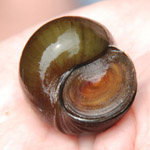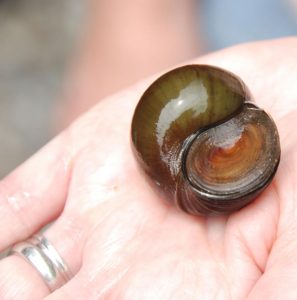
Lake Wicwas Battles Chinese Mystery Snail Invasion
This article was originally published by Rick Green on July 22, 2019, in the Laconia Daily Sun.

There is an unwanted visitor at Wicwas Lake and elsewhere in New Hampshire — it’s called the Chinese Mystery Snail.
Volunteers rake thousands of the snails, an invasive species, out of the 328-acre lake every year.
David Thorpe, who has lived on the shore for 37 years, says the battle to remove the brown snail – which can reach the size of a golf ball – is never-ending.
“What we’ve learned is that they seem to like shallow, muddy bottom water,” he said. “We made a couple of special rakes with a wire mesh backing on them. We try to rake as far out as we can reach to get the muck out of the bottom of the lake and this seems to catch them before they breed and multiply.”
The volunteers throw the snails into the woods, where they dry out and die.
He recommends not touching one with a bare hand.

“They excrete nasty, dirty, polluting excrement,” he said. “They stink something terrible and it’s a difficult odor to remove.”
Thorpe said he doesn’t know if there is a natural way to mitigate the population of the Chinese Mystery Snail, but he has seen ducks eat them.
Despite their smell, they first were brought to the United States in the late-1800s as a food source, said Amy Smagula, of the state Department of Environmental Services.
“We do not recommend raking, unless there is specific approval to do so (the folks who raked on Wicwas had approval),” she said in an email. “The Wetlands Bureau does not allow raking or digging on the lake bottom. Rather, we recommend that the large invasive snails be hand removed individually.”
Smagula confirmed that the snails have an odor.
“They have a funk about them,” she said.
The snails, which are now in many New Hampshire lakes, have a microscopic larvae stage, which can be inadvertently transported from lake to lake in boats, as can other invasive species including Asian clams, variable milfoil and fanwort.
Non-native plants and animals, which lack natural predators, can crowd out native aquatic life and foul boating, swimming and fishing areas.
“An invasive species is literally a boat ride away,” Smagula said.
DES-recommended precautions:
Before leaving any boat launch area —
CLEAN: Clean off all mud, plants, animals, and debris from your boat, trailer, and equipment. Clean off anchors and anchor lines, water intake grates on jet-powered craft, kayak and canoe cockpits, storage compartments, and paddles, too. Dispose of all material away from the waterbody where it won’t wash back into the water.
DRAIN: Drain the motor, bilge, live wells, ballast tanks, storage compartments, and gear. Blow out water in jet-powered craft and tip paddle craft and motors to let out water. Drain all equipment away from the water where runoff won’t flow back into the water. Open/remove drain plugs and keep out/open while trailering. You may need a wrench to remove plugs.
DRY: Dry off everything that came into contact with the water. If launching your boat again within 5 days, thoroughly rinse with clean water somewhere runoff won’t flow back into the water, and towel dry — rinsing with high pressure, hot water between waterbodies is the best practice.
Between visiting waterbodies —
RINSE: Rinse boat hull and trailer with clean water. Flush motor, bilge, live wells, ballast tanks, and storage compartments with clean water per boat manufacturer instructions. It is best to visit a carwash before launching again, especially if the boat has been in a waterbody containing an invasive species infestation.